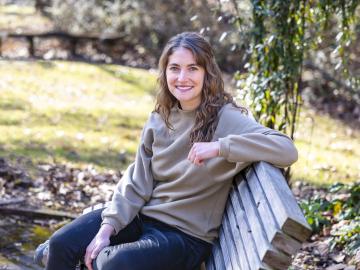
Filter News
Area of Research
News Type
News Topics
- 3-D Printing/Advanced Manufacturing (3)
- Advanced Reactors (1)
- Artificial Intelligence (2)
- Big Data (1)
- Bioenergy (3)
- Biology (3)
- Biomedical (3)
- Biotechnology (2)
- Buildings (2)
- Chemical Sciences (4)
- Clean Water (1)
- Climate Change (4)
- Computer Science (4)
- Coronavirus (4)
- Decarbonization (3)
- Energy Storage (3)
- Environment (5)
- Exascale Computing (1)
- Frontier (1)
- Fusion (3)
- Grid (1)
- High-Performance Computing (1)
- Isotopes (3)
- Machine Learning (1)
- Materials Science (1)
- Mathematics (2)
- Microscopy (1)
- Nanotechnology (1)
- National Security (2)
- Neutron Science (2)
- Nuclear Energy (4)
- Physics (7)
- Polymers (1)
- Security (2)
- Summit (2)
- Sustainable Energy (1)
Media Contacts

Cushman, a Liane B. Russell Fellow at ORNL, has been studying trees and forests in an effort to help humans care for them and improve the health of the planet. Cushman’s fellowship research at ORNL aligns with that, utilizing ground, air and space platforms to study trees and forests in the Southeast.

Although he built his career around buildings, Fengqi “Frank” Li likes to break down walls. Li was trained as an architect, but he doesn’t box himself in. Currently he is working as a computational developer at ORNL. But Li considers himself a designer. To him, that’s less a box than a plane – a landscape scattered with ideas, like destinations on a map that can be connected in different ways.

Chelsea Chen, a polymer physicist at ORNL, is studying ion transport in solid electrolytes that could help electric vehicle battery charges last longer.

Ilenne Del Valle is merging her expertise in synthetic biology and environmental science to develop new technologies to help scientists better understand and engineer ecosystems for climate resilience.

Louise Stevenson uses her expertise as an environmental toxicologist to evaluate the effects of stressors such as chemicals and other contaminants on aquatic systems.

Marcel Demarteau is director of the Physics Division at the Department of Energy’s Oak Ridge National Laboratory. For topics from nuclear structure to astrophysics, he shapes ORNL’s physics research agenda.

Porter Bailey started and will end his 33-year career at ORNL in the same building: 7920 of the Radiochemical Engineering Development Center.

Chuck Kessel was still in high school when he saw a scientist hold up a tiny vial of water and say, “This could fuel a house for a whole year.”

Planning for a digitized, sustainable smart power grid is a challenge to which Suman Debnath is using not only his own applied mathematics expertise, but also the wider communal knowledge made possible by his revival of a local chapter of the IEEE professional society.

When Sandra Davern looks to the future, she sees individualized isotopes sent into the body with a specific target: cancer cells.


